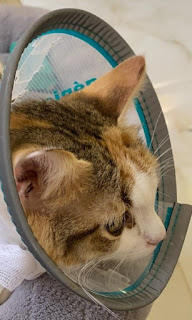THE OTHER SURGICAL PROCEDURES
FACTORS THAT AFFECT WOUND HEALING
Trauma – Excessive licking, biting off the sutures will definitely break the incision site. The presence of maggots can delay wound healing. Traumatic injuries to the muscles and skin will also require time to heal.
 |
| Laceration on limb of a dog |
Water - I am referring to huge amounts of water literally soaking the incision site will not be a good idea!
·
Excessive movement can delay healing. Movements can produce tension at the incision site. This can potentially lead for the incision site to gape open. When your veterinarian request for STRICT CAGE REST, it should be followed. Movement is limited as much as possible.
·
Poor blood supply. Gangrenous skin will never
heal. Debridement of dead tissues is necessary.
·
The use of drugs Example: the use Corticosteroids. The immunosuppressive action of the drug will delay healing process. Collagen formation and wound healing mechanics will be affected when this drug is in the system
· Presence of underlying infection Ex. Diabetes. Poor nutrition. Healing is faster when animal is healthy. The presence of pus can prolong healing times.
ASEPTIC TECHNIQUE
Method to prevent bacterial contamination
The use of surgical drapes to maintain clean surgical environment
All pets recommended for elective surgery are usually observed to recover and heal faster compared to complicated surgeries.
Y Clean wounds should heal within 5 - 7 days
Wound in a spayed dog will heal within 5-7 days compared to a wound of a dog with severe abscessation or trauma.
Why we do surgery on the following conditions? Primary reason is to have better result, faster recovery,
Maggot infested wounds. Removal of the maggots will facilitate better recovery rate rather than just treating with the proper anti-parasitic agent.
Dead tissues are manually removed.
Gangrenous mammary glands are exteriorized
Bone fractures are repaired as much as possible to close the skin
Uroliths are removed from the bladder to remove obstruction
Lump removal requires a good margin of healthy tissue to be excised to avoid further spread
Protrusion of intestinal lining to the abdominal wall will demand hernia repairs
REMINDERS
Presence of blood on the first day should be normal, but this should never be a pooling of liquid.
Make sure the wound of your pet coming from surgery is dry.
Discharges can be normal on the day when your pet goes home,
but the succeeding days should be dry
ELIZABETHAN COLLARS
known as the "cone of shame"!
it is a medical device that can protect the surgical site from excessive trauma.
It prevents excessive licking of the wound.
Any opening or discharges observed at the incision site is best checked by your veterinarian.
 |
| Gaping wound observed on incision site due to excessive licking |
Follow your veterinarian's instructions.
A A written order is usually given to the owners on how the medications are given and their timings. Complicated surgeries will require extra attention. There will be times that the wound healing process does not heal as expected, it is best to have your veterinarian see your pet for re-evaluation. The surgery is primarily the first part for healing to start. The second part of healing remains on the succeeding days at home.
Our success on the surgical procedure lies also on the recovery during post-op care.
Source:
FF
y





Comments
Post a Comment